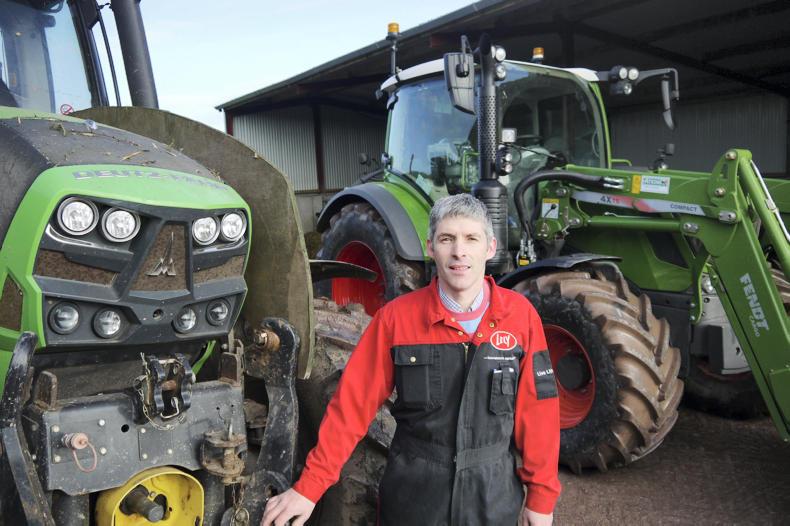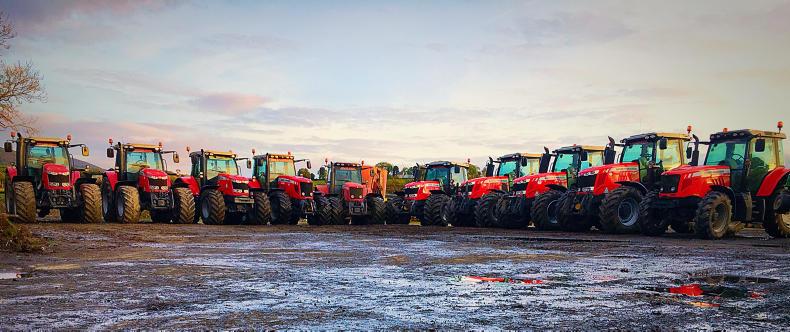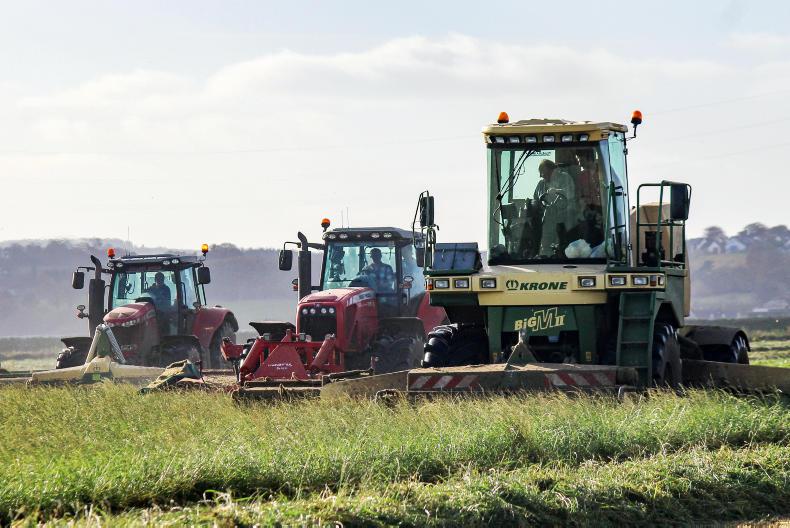Ballynoe, east Cork

What work do you conduct?
We specialise in baled silage, slurry spreading, hedge-cutting and a small amount of reseeding work.
What is the biggest part of your business?
Baled silage. Last year we made approximately 19,000 round bales with one Lely Welger baler-wrapper combination. I ran two combinations in the past but now I have just one. Slurry is second as regards workload after baled silage. The last slurry tanker I had was a November 2008 machine. It would have needed its third set of tyres this year so I replaced it instead. Hedge-cutting follows after this but there’s very little out of it by the time you have all expenses accounted for. Our focus is firmly on silage and slurry.
What equipment do you have?
Deutz-Fahr 6180.Deutz-Fahr 6160 with Quickie 66 loader.Fendt 313 with 4X75 compact front loader.John Deere 6830 with Quickie 55 front loader.Zetor 12111.Lely Welger RP 245 Profi round-baler combined with a GoWeil wrapper unit. 2,600 gallon Hi-Spec galvanised tanker with Esiflow trailing-shoe.Twose TP600 hedgecutter.Claas 2800 rake.John Deere 1365 mower-conditioner.Lely 770 Tedder.What is the best machine you run?
The Lely-Welger wrapper combination.
What’s the biggest challenge at the moment?
Working to calendar dates as opposed to ground conditions and the amount of rain that has fallen and continues to fall. We did no autumn reseeding last backend as it was so wet. Getting the last of the silage finished was a real struggle. Slurry spreading is a real challenge at the moment as ground is so soft and tanks are full everywhere. Generally speaking we have no issue getting labour and the same guys return each year. The hours can be long but that’s the nature of the business. For our customers it’s the price they are getting for their milk and beef that is the biggest challenge.
What area do you cover?
I work within a 20km radius of my base in Ballynoe, east Cork. Most of our customers are dairy or beef farmers with a few tillage customers among them.
Have you made any modifications to any machinery?
On our baler, we changed the feeder rake on top of the pickup. We shortened the bars at the back off the board above the pickup rotor. By making this small change we got at least another six to seven bales per hour out of the baler as the grass flowed more freely into the feed-rotor.
How will Brexit affect your business?
On the contracting side, it could increase the price of machines imported. We also fatten cattle so it could depress the price of beef going forward. It’s hard to know at this stage.
Any future investments planned?
We are using one trailed mower conditioner at the moment. Two of the tractors are fitted with front linkage so we are considering a front-mounted mower conditioner as it would speed up our mower output a lot. I’m also interested in the Kverneland Fastbale.
It sounds like a great machine so we will hopefully get a demonstration to test it out.

Killen Brothers run a fleet of 13 Massey Ferguson tractors in their contracting business.Killen Brothers run a fleet of 13 Massey Ferguson tractors in their contracting business.
Derry, Northern Ireland
What work do you do?
The majority of our business is silage making and slurry. We harvest somewhere between 7,000 acres and 10,000 acres per year including grass silage, wholecrop and maize. Grass is still the biggest part of our business but with more AD plants being installed, maize and wholecrop will become more popular. We spread a lot of slurry using both tankers and umbilical systems which keeps us busy almost all year. After this, tillage work and 450 cows housed all year round keep us busy.
What tractors do you run?
A fleet of 13 Massey Ferguson’s – 2 x 7726, 1 x 7624, 1 x 6499, 3 x 7718, 3 x 7618, 2 x 6480 and 1 x 6616.
What loaders and forage harvesters do you run?
We have three JCB loading shovels – a 435s, a 416s and a TM320s. For picking up we have two Krone BiG-Xs – a 700 and a 630. These are both fitted with grass pickups but we have a six-row maize head and a 20ft wholecrop to fit on to the both of them also.
Other equipment in your fleet?
50ft Krone 1400 four-rotor rake, 30ft Claas 2900 rake, two sets of Krone triple butterfly mowers, BiG-M Mark II – all of which are fitted with groupers, a mixture of eight 18ft and 20ft Redrock and Kane trailers and a new Lemken 3m one-pass.
You said you spread a lot of slurry, what machinery do you use?
We use four umbilical systems almost all year round. Some of these are fed from a pump in the farmyard whereas others are fed using a combination of tankers. We have two 4,500 gallon Redrock tankers and four 3,000 gallon Abbey tankers to keep slurry moving during the busiest times. Ground is so soft now we can only travel with the umbilical systems.
Best machine you have bought
The Massey-Ferguson 6499 and 6480. These have been very reliable over the years and have served us well. Both are first to leave the yard every morning and have in excess of 10,000 hours on the clock.
Any modifications made to any machine?
It’s not a modification but more an increase in capacity. We recently purchased a 16ft folding Redrock silage fork for the JCB 435s loader. It has huge capacity and means we can clear large loads of grass quicker and keep the silage outfit running more efficiently.
What is the biggest challenge to your business at the moment?
Calendar farming and wet weather. There are a lot of our customers under pressure for slurry storage as the land is simply too wet to travel. At the moment we are very busy with our four umbilical systems and ground is very soft. If this weather continues any longer farmers including ourselves will struggle to get silage made for the year ahead. The spring has yet to arrive and the winter won’t leave.
Is Brexit a worry?
At the minute not really but maybe when it comes to fruition we will be concerned that machinery will get more expensive. It’s hard to know what will happen.
Ballynoe, east Cork

What work do you conduct?
We specialise in baled silage, slurry spreading, hedge-cutting and a small amount of reseeding work.
What is the biggest part of your business?
Baled silage. Last year we made approximately 19,000 round bales with one Lely Welger baler-wrapper combination. I ran two combinations in the past but now I have just one. Slurry is second as regards workload after baled silage. The last slurry tanker I had was a November 2008 machine. It would have needed its third set of tyres this year so I replaced it instead. Hedge-cutting follows after this but there’s very little out of it by the time you have all expenses accounted for. Our focus is firmly on silage and slurry.
What equipment do you have?
Deutz-Fahr 6180.Deutz-Fahr 6160 with Quickie 66 loader.Fendt 313 with 4X75 compact front loader.John Deere 6830 with Quickie 55 front loader.Zetor 12111.Lely Welger RP 245 Profi round-baler combined with a GoWeil wrapper unit. 2,600 gallon Hi-Spec galvanised tanker with Esiflow trailing-shoe.Twose TP600 hedgecutter.Claas 2800 rake.John Deere 1365 mower-conditioner.Lely 770 Tedder.What is the best machine you run?
The Lely-Welger wrapper combination.
What’s the biggest challenge at the moment?
Working to calendar dates as opposed to ground conditions and the amount of rain that has fallen and continues to fall. We did no autumn reseeding last backend as it was so wet. Getting the last of the silage finished was a real struggle. Slurry spreading is a real challenge at the moment as ground is so soft and tanks are full everywhere. Generally speaking we have no issue getting labour and the same guys return each year. The hours can be long but that’s the nature of the business. For our customers it’s the price they are getting for their milk and beef that is the biggest challenge.
What area do you cover?
I work within a 20km radius of my base in Ballynoe, east Cork. Most of our customers are dairy or beef farmers with a few tillage customers among them.
Have you made any modifications to any machinery?
On our baler, we changed the feeder rake on top of the pickup. We shortened the bars at the back off the board above the pickup rotor. By making this small change we got at least another six to seven bales per hour out of the baler as the grass flowed more freely into the feed-rotor.
How will Brexit affect your business?
On the contracting side, it could increase the price of machines imported. We also fatten cattle so it could depress the price of beef going forward. It’s hard to know at this stage.
Any future investments planned?
We are using one trailed mower conditioner at the moment. Two of the tractors are fitted with front linkage so we are considering a front-mounted mower conditioner as it would speed up our mower output a lot. I’m also interested in the Kverneland Fastbale.
It sounds like a great machine so we will hopefully get a demonstration to test it out.

Killen Brothers run a fleet of 13 Massey Ferguson tractors in their contracting business.Killen Brothers run a fleet of 13 Massey Ferguson tractors in their contracting business.
Derry, Northern Ireland
What work do you do?
The majority of our business is silage making and slurry. We harvest somewhere between 7,000 acres and 10,000 acres per year including grass silage, wholecrop and maize. Grass is still the biggest part of our business but with more AD plants being installed, maize and wholecrop will become more popular. We spread a lot of slurry using both tankers and umbilical systems which keeps us busy almost all year. After this, tillage work and 450 cows housed all year round keep us busy.
What tractors do you run?
A fleet of 13 Massey Ferguson’s – 2 x 7726, 1 x 7624, 1 x 6499, 3 x 7718, 3 x 7618, 2 x 6480 and 1 x 6616.
What loaders and forage harvesters do you run?
We have three JCB loading shovels – a 435s, a 416s and a TM320s. For picking up we have two Krone BiG-Xs – a 700 and a 630. These are both fitted with grass pickups but we have a six-row maize head and a 20ft wholecrop to fit on to the both of them also.
Other equipment in your fleet?
50ft Krone 1400 four-rotor rake, 30ft Claas 2900 rake, two sets of Krone triple butterfly mowers, BiG-M Mark II – all of which are fitted with groupers, a mixture of eight 18ft and 20ft Redrock and Kane trailers and a new Lemken 3m one-pass.
You said you spread a lot of slurry, what machinery do you use?
We use four umbilical systems almost all year round. Some of these are fed from a pump in the farmyard whereas others are fed using a combination of tankers. We have two 4,500 gallon Redrock tankers and four 3,000 gallon Abbey tankers to keep slurry moving during the busiest times. Ground is so soft now we can only travel with the umbilical systems.
Best machine you have bought
The Massey-Ferguson 6499 and 6480. These have been very reliable over the years and have served us well. Both are first to leave the yard every morning and have in excess of 10,000 hours on the clock.
Any modifications made to any machine?
It’s not a modification but more an increase in capacity. We recently purchased a 16ft folding Redrock silage fork for the JCB 435s loader. It has huge capacity and means we can clear large loads of grass quicker and keep the silage outfit running more efficiently.
What is the biggest challenge to your business at the moment?
Calendar farming and wet weather. There are a lot of our customers under pressure for slurry storage as the land is simply too wet to travel. At the moment we are very busy with our four umbilical systems and ground is very soft. If this weather continues any longer farmers including ourselves will struggle to get silage made for the year ahead. The spring has yet to arrive and the winter won’t leave.
Is Brexit a worry?
At the minute not really but maybe when it comes to fruition we will be concerned that machinery will get more expensive. It’s hard to know what will happen.








 This is a subscriber-only article
This is a subscriber-only article
















SHARING OPTIONS: